 I have the opportunity to talk with women of different ages about many things. It’s one of the perks of my life. This summer, I am sharing ‘A Series of Conversations’ – Articles that have come out of conversations with friends. I’m sure they will be what someone needs to hear, as they have been for me.
I have the opportunity to talk with women of different ages about many things. It’s one of the perks of my life. This summer, I am sharing ‘A Series of Conversations’ – Articles that have come out of conversations with friends. I’m sure they will be what someone needs to hear, as they have been for me.
The information doesn’t come from a place of education or an expert; it comes from women like you and me, with life experience in the trenches.
One of Those Days!
Recently, I had one of those days when I didn’t want to talk with anyone. I was tired and feeling down. I was still carrying the weight of the day before, which was long and chaotic, and the weight of this new day, which would be more of the same. However, on Tuesdays, I walk with my friend Livia. I wanted to cancel but didn’t let myself. I was glad I followed my feelings because my friend, uncharacteristically, was in the same place. We had a good laugh over this unexpected connection. On our walk, we listened to each other, allowed ourselves to feel, and buoyed each other up. It helped us emotionally and mentally prepare for the day and the coming week.
On our walk, we discussed the question we were both dealing with: How do you hang in when things are hard, may stay hard for a while, and may not end as you hope? The answer came in single words and short phrases that have helped us over the years.
Words & Phrases
YET – In our conversation, Livia brought up the word YET. Using this word gives space for thought and growth, and can lead to clarity, and keep us from beating ourselves or others up. For example, “I haven’t learned this yet.” “They haven’t decided yet.” “This isn’t resolved yet.” YET is a powerful word that can help us manage the story we’re telling ourselves and help us have a clearer perspective.
RIGHT NOW – The phrase, Right Now, was the next idea we shared. It can be pivotal when dealing with what you have little control over. For example, “This is what it is for right now.” “Right now, I can do this.” “This is useful to me right now.” “This won’t last forever, but I need a plan for right now.”
As we talked about ‘right now’, we felt this short phrase helped us keep at the forefront of our minds the knowledge that nothing is stagnant, everything grows, and things change, but this is what it is for right now, and we can do it because it won’t stay where it is. Like the word YET, RIGHT NOW helps us manage the story we are carrying and keeps our perspective clearer. Both keep us out of the negative, which is rarely a helpful place to be.
SIMPLE, EASY, FUN, and PRAYER – We are both caregivers, and technology isn’t an issue there. But Livia is a business teacher and life coach, and I am a writer. We use technology, and it keeps changing, like everything else. For example, I know how to use my writing platform right now, but… We did a lot of laughing at this point in the conversation because we both have wanted to bang on our computers or throw our phones against the wall. Here again, the words YET and RIGHT NOW are useful.
When I am in tech trouble, I pray because I know I will see or think of something I have missed. It happens EVERY TIME! It always amazes me when I work something out and don’t even know for sure what I did. Livia told me that when tech is making her crazy, she has a simple mantra she repeats to herself to maintain calm and peaceful while figuring it out: “This is simple, this is easy, this is fun.” She said, “It helps keep the lid on my frustration.” I’ve been giving this a try, and it is helpful, like prayer.
HEARTS- I received a gift from Livia. It isn’t as much about words as it is about looking for the good and seeing the blessings. Years ago, Livia began noticing hearts everywhere. As she and I have walked together over the last year, she has taught me to see them. She says they are her moment-by-moment messages from God, that she is seen, loved, and cared for.
I’ve been looking for hearts for some time now. Recently, I saw a perfect heart in the clouds. There was a bright blue patch, surrounded by clouds, in the shape of a heart. I couldn’t pull over to take a photo, but I had seen it. It had been one of those busy, chaotic mornings, and seeing the heart helped me breathe and smile.
was a bright blue patch, surrounded by clouds, in the shape of a heart. I couldn’t pull over to take a photo, but I had seen it. It had been one of those busy, chaotic mornings, and seeing the heart helped me breathe and smile.
One day, as I pushed my mom’s wheelchair down the street, something I didn’t have time for, but she needed, I saw a perfect heart in a bush. What! How can that be? But there it was, a gift from God for taking time to care for and love another despite my list. Both Livia and I ask to see hearts when we need to lift our spirits, change our perspective, or improve our story. It has become a practice for me, as it has been for Livia for years.
Words Matter!
Life has its hard moments, its hard weeks, months, and sometimes, years. We are often called on missions we didn’t plan on. Sometimes, we need to change course when we would rather not. Things don’t always go our way. But we can use the word YET, the phrase RIGHT NOW, to manage hard things, like technology, by remembering PRAYER, SIMPLE, EASY, and FUN, and look for HEARTS to help us stay centered, happy, and hopeful; a few simple tools to manage big things.
As we practice keeping our perspective clear, as we work on telling ourselves more helpful stories, we can and will live better, more fulfilling lives.
Words matter! They do. Ultimately, all we can control or change is ourselves. We do that best when we find ways (systems) that help us manage the story we tell ourselves, when we keep a handle on our perspective, and as Livia put it, “Keep a lid on frustration.” Staying on top of what we tell ourselves is a practice, and as we get better and more consistent at doing it, life lightens up, even when the circumstances stay the same. This isn’t resolved YET. It is what it is RIGHT NOW. I can manage technology and other hard things as I keep it SIMPLE, believe in EASY, look for the FUN, and see HEARTS. Messages of love, hope, and change are everywhere. : )
These words and phrases are simple tools to manage big things.
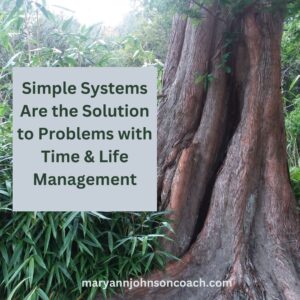 How Can You Remind Yourself to Care for Self?
How Can You Remind Yourself to Care for Self?


 I have had this recurring thought in the last five years – “Why are you writing? You aren’t raising kids anymore. You aren’t homeschooling. You’re getting older. Are you even relevant?” Then I get an email from a young mom thanking me for helping her see what she couldn’t see, or from an older mother or grandmother thanking me for reminding her of what she already knew.
I have had this recurring thought in the last five years – “Why are you writing? You aren’t raising kids anymore. You aren’t homeschooling. You’re getting older. Are you even relevant?” Then I get an email from a young mom thanking me for helping her see what she couldn’t see, or from an older mother or grandmother thanking me for reminding her of what she already knew.
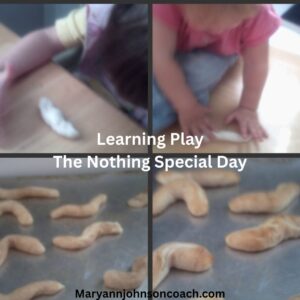 Back in the day, when my grands were small, I did many learning activities with them. I enjoyed it and so did they. As I mentioned earlier this spring, I’m sharing some of those past learning activities with you because you can have as much enjoyment and fun with your children or grands as I did. Sometimes all we need is an idea, and then we can run with it. So here goes!
Back in the day, when my grands were small, I did many learning activities with them. I enjoyed it and so did they. As I mentioned earlier this spring, I’m sharing some of those past learning activities with you because you can have as much enjoyment and fun with your children or grands as I did. Sometimes all we need is an idea, and then we can run with it. So here goes!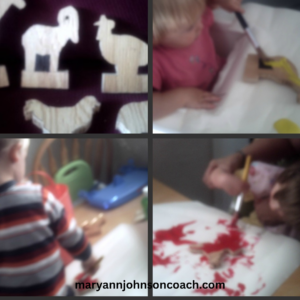 paper. When they were done and wanted another animal and a different color, we traded papers. Grandpa was very satisfied with the result. This particular range wouldn’t have his usual perfection, but it had memories and was fun to use.
paper. When they were done and wanted another animal and a different color, we traded papers. Grandpa was very satisfied with the result. This particular range wouldn’t have his usual perfection, but it had memories and was fun to use.
 A few Sundays ago, my husband tuned in to a show my mom likes to watch,
A few Sundays ago, my husband tuned in to a show my mom likes to watch, 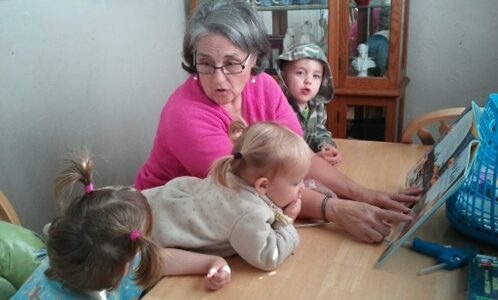
 One day in 2011, I found the most amazing book at the library!!! I happened across it accidentally. It was about Leonardo Da Vinci and the amazing visions he had. But that wasn’t all. The book showed how, in time, all his inventive ideas were created by other people and who those people were. Oh my gosh, I wanted to share this with my grands.
One day in 2011, I found the most amazing book at the library!!! I happened across it accidentally. It was about Leonardo Da Vinci and the amazing visions he had. But that wasn’t all. The book showed how, in time, all his inventive ideas were created by other people and who those people were. Oh my gosh, I wanted to share this with my grands. Our Super-duper Rocket-propelled Robot
Our Super-duper Rocket-propelled Robot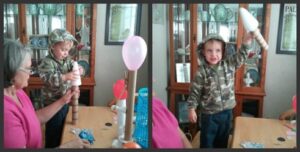

 I have the opportunity to talk with women of different ages about many things. It’s one of the perks of my life. This summer, I am sharing ‘A Series of Conversations’ – Articles that have come out of conversations with friends. I’m sure they will be what someone needs to hear, as they have been for me.
I have the opportunity to talk with women of different ages about many things. It’s one of the perks of my life. This summer, I am sharing ‘A Series of Conversations’ – Articles that have come out of conversations with friends. I’m sure they will be what someone needs to hear, as they have been for me. was a bright blue patch, surrounded by clouds, in the shape of a heart. I couldn’t pull over to take a photo, but I had seen it. It had been one of those busy, chaotic mornings, and seeing the heart helped me breathe and smile.
was a bright blue patch, surrounded by clouds, in the shape of a heart. I couldn’t pull over to take a photo, but I had seen it. It had been one of those busy, chaotic mornings, and seeing the heart helped me breathe and smile.
 Summer is the perfect time to learn about stars because after you do a few fun activities, you can lie under the stars as a family, breathe the air, and stare into the night sky. What a relaxing thing to do. As I said a few weeks ago, this summer I am sharing some old grandma school times I had with my grands back in 2011. Bigger kids like helping younger ones, so even though these are simple things, you can do them as a family and get the older kids involved. Just don’t pick a Friday or Saturday night. : )
Summer is the perfect time to learn about stars because after you do a few fun activities, you can lie under the stars as a family, breathe the air, and stare into the night sky. What a relaxing thing to do. As I said a few weeks ago, this summer I am sharing some old grandma school times I had with my grands back in 2011. Bigger kids like helping younger ones, so even though these are simple things, you can do them as a family and get the older kids involved. Just don’t pick a Friday or Saturday night. : )
 Two weeks ago, in the article
Two weeks ago, in the article For example, when my 3-year-old grandson was being a pill, his mom would stop, get down to his level, and say, “What’s wrong, little son?” When I watched her, I knew she was ticked off, but
For example, when my 3-year-old grandson was being a pill, his mom would stop, get down to his level, and say, “What’s wrong, little son?” When I watched her, I knew she was ticked off, but 

 white face paint and lipstick. The white face paint was Halloween makeup I bought many years ago. It worked well enough. For red, we used what grandma had, lipstick. As I say, keep it simple. Then we tried on all the glasses, boas, ties, and other costume items. Jack fell in love with a hat and a bow tie. He asked me if he could have them. I said he could surely borrow them. “I don’t like borrow” he said, “I want to have them!” LOL
white face paint and lipstick. The white face paint was Halloween makeup I bought many years ago. It worked well enough. For red, we used what grandma had, lipstick. As I say, keep it simple. Then we tried on all the glasses, boas, ties, and other costume items. Jack fell in love with a hat and a bow tie. He asked me if he could have them. I said he could surely borrow them. “I don’t like borrow” he said, “I want to have them!” LOL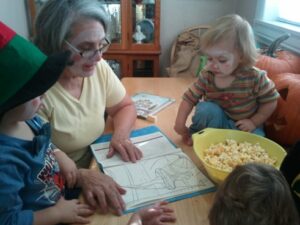 sometimes we aren’t! We managed with what we had, and I made a circus book. I found a terrific site of circus pictures, printed them off, and put them into a binder. (Jack, Mary, and Maggie used it until it fell apart.) It also made a great circus coloring book.
sometimes we aren’t! We managed with what we had, and I made a circus book. I found a terrific site of circus pictures, printed them off, and put them into a binder. (Jack, Mary, and Maggie used it until it fell apart.) It also made a great circus coloring book.
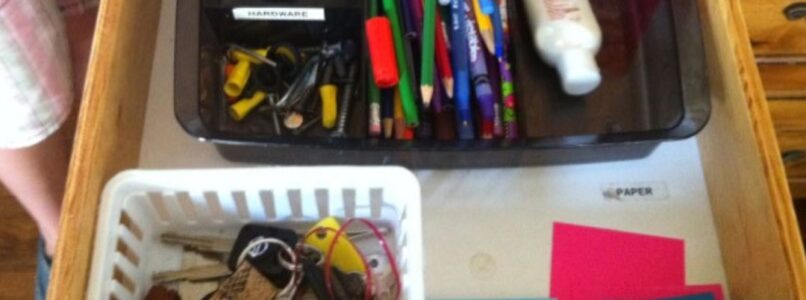
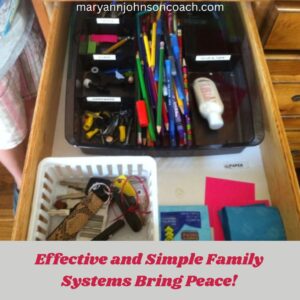 This week, as I walked with my friends Livia and Alysia, the conversation turned to their teens and the issues surrounding accomplishing things at home. At one point, Livia mentioned the need for successful systems. I told them how interesting the conversation was because I was working on my article for today, and it was about creating
This week, as I walked with my friends Livia and Alysia, the conversation turned to their teens and the issues surrounding accomplishing things at home. At one point, Livia mentioned the need for successful systems. I told them how interesting the conversation was because I was working on my article for today, and it was about creating